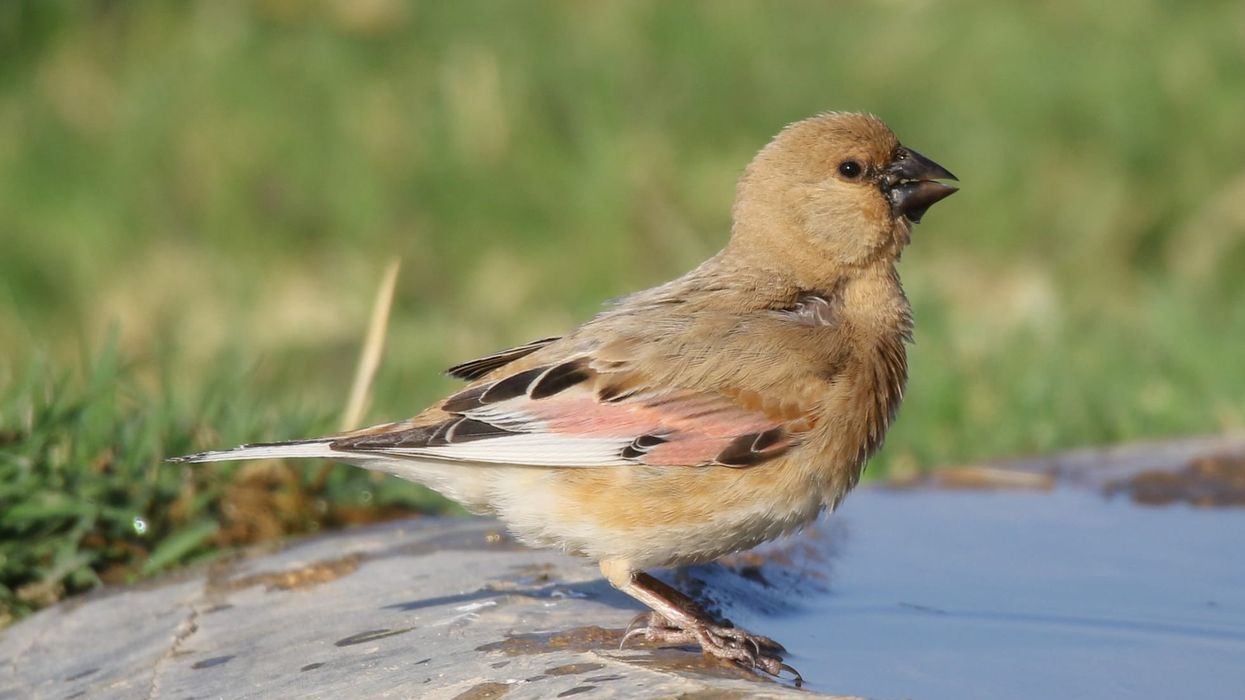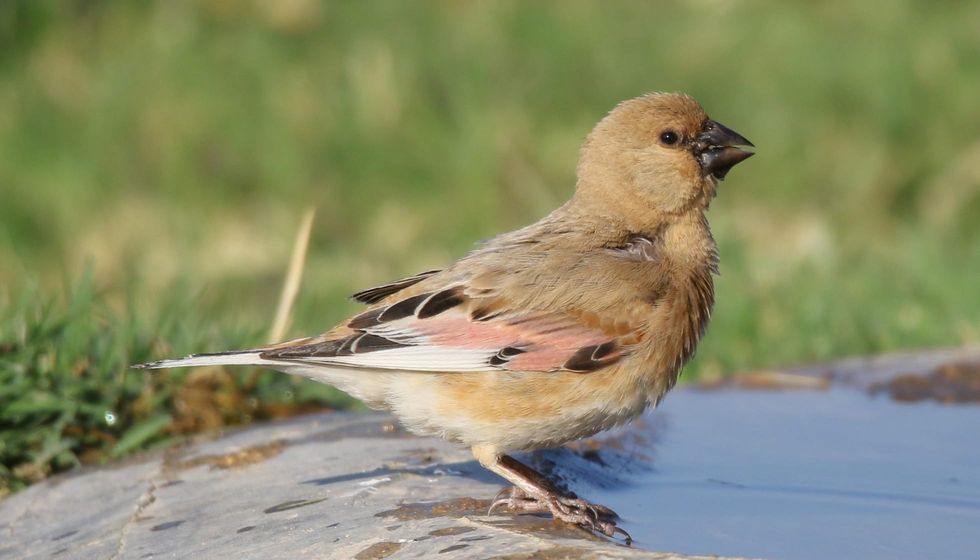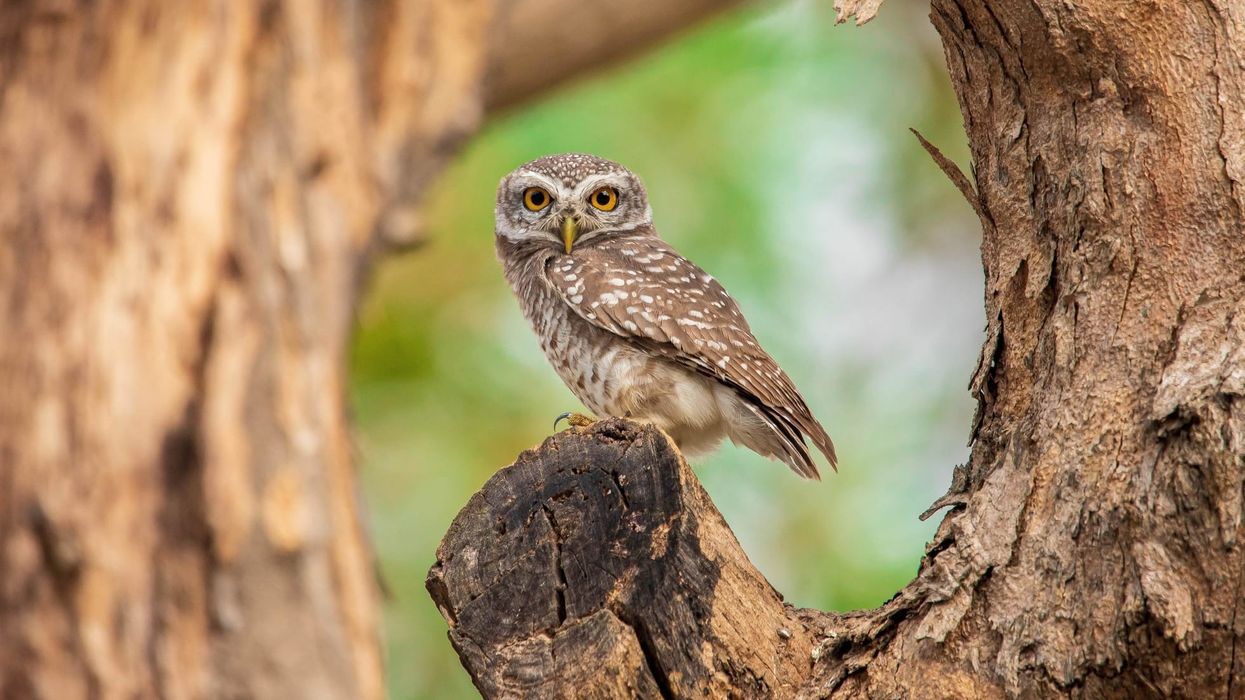The desert finch (Rhodospiza obsoleta), a species of the order Passeriformes, family Fringillidae, is best known for the rosy-pink slashes on each wing. The species is also known as Lichtenstein's desert finch.
These small birds are quite small and the average weight and length of the species are 0.03-0.05 lb (17-28 g) and 5.70-5.90 in (14.5-15 cm) respectively. The average wingspan of the desert finches is 10 in (26 cm).
The birds possess a black bill while the flight feathers and the tail have black and white streaks. The birds have sandy brown-colored bodies. The female birds are less bright than the male finches.
While talking about the desert finch habitat, the species primarily dwell in desert areas where water availability is high, but one can also find these birds in cultivated valleys, low mountains, and foothills. Unlike other species, these birds migrate locally and are often found in flocks near human settlements.
The desert finches usually prey on seeds, buds, vegetables, and sometimes on insects as well. The Internation Union for the Conservation of Nature declared the species as Least Concern and the major causes of population decline are predation, loss of habitat, use of pesticides, and window collisions.
Some of the species of finches are prone to diseases such as Mycoplasmal conjunctivitis.
Keep on reading to learn more interesting facts about the desert finch. If you want to know more exciting information about different animals, check out blue jay facts and scissor-tailed flycatcher facts.
Desert Finch Interesting Facts
What type of animal is a desert finch?
The desert finch (Rhodospiza obsoleta) belongs to the group of true finches and is also known as Lichtenstein's desert finch. The birds are omnivores and primarily prey on seeds, buds, and insects.
What class of animal does a desert finch belong to?
The desert finches belong to the class of Aves, the family of Fringillidae, and the Rhodospiza genus. These small passerine birds are from the group of true finches.
How many desert finches are there in the world?
The exact population of the desert finch (Rhodospiza obsoleta) birds is not known as of now but several species of the true finches such as the Eurasian bullfinch, American goldfinch, and many more are declared as of Least Concern by the IUCN Red List. True finches are widely distributed in different parts of the world.
The population of a popular species, the house finch is more than 31 million in the United States.
Where does a desert finch live?
While talking about the desert finch distribution, the species is generally found in different parts of Middle Eastern and North African countries. A small population of desert finches is also observed in a few regions of Europe such as southern Spain.
What is a desert finch's habitat?
The desert finch (Rhodospiza obsoleta) primarily dwells in desert areas where water availability is high, but one can also find these birds in cultivated valleys, low mountains, and foothills. Unlike other species, these birds migrate locally and are often found in flocks near human settlements.
Who do desert finches live with?
Like other species of true finch birds, the desert finch is social and generally prefers to live in small groups or flocks. Unlike other birds, the desert finch migrates locally.
Some of them form flocks with other species of true finch birds. During the breeding season, the bird is often found in pairs. An interesting fact is that females generally establish dominance over males.
How long does a desert finch live?
There is no exact information regarding the desert finch life or longevity but the true finch birds are believed to live for around four to seven years in the wild. Also, the average lifespan of the house finch bird is around 11-12 years.
How do they reproduce?
It is said that like other true finch birds, the desert finch birds follow the same breeding patterns. The bird is monogamous which means only one pair is formed at a time, no information regarding the breeding season is available as of now.
Some of the species of true finch breed after heavy rainfall while some mate between March and August.
The male bird is involved in several courtship displays to grab the attention of the female. The male finch generally flies in an unusual manner, sings loud songs for the female bird.
The females prefer the male who would have bright-colored feathers. After forming a pair, the male bird protects the partner. The nests are solely constructed by the females on trees in the spring season, they usually prefer the fruit trees.
Around four to six pale green eggs are laid and the incubation of eggs is only performed by females. The male bird generally feeds the chicks or young birds.
What is their conservation status?
The Internation Union for the Conservation of Nature declared the species as of Least Concern and the major causes of population decline are predation, loss of habitat, window collisions, and use of pesticides. Some of the species of finches are prone to several diseases such as Mycoplasmal conjunctivitis.
Desert Finch Fun Facts
What do desert finches look like?

The desert finch bird possesses a charcoal black bill while the flight feathers and the tail have black and white streaks. The birds have sandy brown-colored bodies while the species is best known for the rosy-pink slashes on each wing. The female bird has a pale body compared to the male birds.
How cute are they?
Like other species of the finch group, the desert finch birds are also beautiful. Apart from their appearance, their behavior mesmerizes everyone.
The protective nature of the male birds towards their partner, flapping wings, and hovering around the females would enchant everyone. The way the birds love their family and feed their chicks would really be a delight to watch.
How do they communicate?
Like other species of true finches, the desert finch uses similar methods of communication. The birds generally use several calls and songs to remain in touch with the flocks. Also, during the breeding season, the birds are involved in several courtship displays to attract partners.
How big is a desert finch?
While talking about the desert finch size, these small birds are quite small and the average weight and length of the species are 0.03-0.05 lb (17-28 g) and 5.70-5.90 in (14.5-15 cm) respectively. The birds are twice the size of bee hummingbirds and ruby-crowned kinglets.
How fast can a desert finch fly?
The exact speed of the desert finches is not known as of now but a few species, such as the zebra finch, are known for moving quite fast.
How much does a desert finch weigh?
The average weight of the desert finch bird is 0.03-0.05 lb (17-28 g).
What are the male and female names of the species?
There are no specific names given to the male and female birds of the desert finch species.
What would you call a baby desert finch?
Baby desert finches are called chicks.
What do they eat?
The desert finch birds are omnivores and primarily prey on seeds, buds, vegetables, and occasionally on insects as well such as grasshoppers and oleander aphids. This is also similar to the Arizona finch.
Are they dangerous?
Generally, the birds dwell near human settlements but do not pose any threats but the species is quite is protective when it comes to their family or group. The desert finch birds also have a sharp bill and may attack if someone tries to approach or threaten them.
Would they make a good pet?
People usually keep a few species of the true finches, such as zebra finches, as pets but captivity often makes the bird weaker as they primarily belong to the wild. Instead of keeping them as pets, people usually hang bird feeders in the yard and enjoy watching them.
You should keep the feeder clean as the birds are prone to several eye infections.
Did you know...
Several species of finches, such as the American goldfinch and the lesser goldfinch, are found in Arizona. The species are granivores but sometimes also prey on insects.
How many varieties of finch are there?
There are around 17 species of true finch birds found in the North American continent, also the Fringillidae family consists of around 200 species that are divided into 5o genera. The prominent species of the finch group are siskins, redpolls, evening, pine grosbeaks, strawberry finches, and red finches.
The birds are known for their conical bills, bright wings, and notched or pointed tails. Each species has a different flight call.
Species such as the house finch, white-winged crossbill, pine sisnik, and common redpoll have a population of over 30 million.
While the population of a few vulnerable or threatened species such as cassia crossbill, brown-caped rosy finch, black rosy finch is reducing rapidly due to several factors like loss of habitat, predation, usage of pesticides, window collisions. Also, over the years, the disease Mycoplasmal conjunctivitis is being reported in several species.
How do finches survive in the desert?
As the name suggests, the desert finches dwell in deserts but the species choose a habitat where the water availability is high.
Here at Kidadl, we have carefully created lots of interesting family-friendly animal facts for everyone to discover! Learn more about some other birds including rhinoceros hornbill facts and boreal chickadee facts.
You can even occupy yourself at home by coloring in one of our Desert Finch coloring pages.









